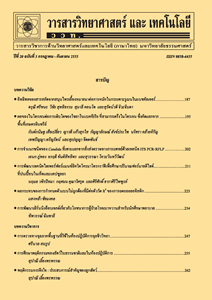Evaluation of the Filtration Efficiency of Common Fabric Materials Against 0.3 µm Size Particle
Main Article Content
Abstract
A shortage of disposable surgical masks can be expected during the COVID-9 pandemic in Thailand. Some individuals may want to use common fabric materials for respiratory protection because of shortage or affordability reasons. This work aims to experimentally study the filtration efficiency of common fabric materials against 0.3 µm size particles. This work was carried out by the ASTM F2299-03 standard test method for determining the filtration efficiency and penetration of fabric materials by particulates using polystyrene latex spheres. In this study, five major categories of fabric materials, including microfiber cloth, cotton fabric, handwoven fabric, nano cloth, and polyester fabric, were tested with a particle diameter of about 0.3 µm at a face velocity of about 10.6 cm/s and compared with the penetration levels for N95 mask filter media. The results showed that these fabric materials tested in the study had a filtration efficiency of 0.3 µm particle in the range between 9 and 36 %. The penetration levels of these fabric materials against 0.3 µm size particles were much higher than the penetrations for the control N95 mask filter media. Results obtained in the study show that common fabric materials may provide marginal protection against submicron-size particles, including PM2.5.
Article Details
References
Department of Disease Control, COVID-19 Situation Report, Available Source: https://covid19.ddc.moph.go.th, October 24, 2020. (in Thai)
Thepnuan, D., Yabueng, N., Chantara, S., Prapamontol, T. and Tsai, Y.I., 2020, Simultaneous determination of carcinogenic PAHs and levoglucosan bound to PM2.5 for assessment of health risk and pollution sources during a smoke haze period, Chemosphere 257: 127154.
Fushimi, A., Hasegawa, S., Takahashi, K., Fujitani, Y., Tanabe, K. and Kobayashi, S., 2008, Atmospheric fate of nuclei-mode particles estimated from the number concentrations and chemical composition of particles measured at roadside and background sites, Atmos. Environ. 42: 949-459.
Intra, P. and Siri-achawawath, T., 2019, Development of an online particulate monitoring system for measurement of the mass and number concentrations and size distributions of ambient PM10, PM2.5 and sub-400 nm particles, Songklanakarin J. Sci. Technol. 41: 1339-1347.
Srivastava, A., 2021, COVID-19 and air pollution and meteorology – An intricate relationship: A review, Chemosphere 263: 128297.
Leiva, G.M.A., Santibañez, D.A., Ibarra, S., Matus, P. and Seguel, R., 2013, A five-year study of particulate matter (PM2.5) and cerebrovascular diseases, Environ. Pollut. 181: 1-6.
O’Dowd, K., Nair, K.M., Forouzandeh, P., Mathew, S., Grant, J., Moran, R., Bartlett, J., Bird, J. and Pillai, S.C., 2020, Face masks and respirators in the fight against the COVID-19 pandemic: A review of current materials, advances and future perspectives, Materials 13: 3363.
El-Atab, N., Qaiser, N., Badghaish, H., Shaikh, S.F. and Hussain, M.M., 202, Flexible nanoporous template for the design and development of reusable anti-COVID-19 hydrophobic face masks, ACS Nano 14: 7659-7665.
Sickbert-Bennett E.E., Samet J.M., Clapp, P.W., Tong, H., Weber, D.J. and Bennett, W.D., 2020, Filtration efficiency of hospital face mask alternatives available for use during the COVID-19 pandemic, JAMA Int. Med. 180: 1607-1612.
Konda, A., Prakash, A., Moss, G.A., Schmoldt, M., Grant, G.D. and Guha, S., 2020, Aerosol filtration efficiency of common fabrics used in respiratory cloth masks, ACS Nano 14: 6339-6347.
Aydin, O., Emon, B., Cheng, S., Hong, L., Chamorro, L.P., Saif, M.T.A., 2020, Performance of fabrics for home-made masks against the spread of COVID-19 through droplets: A quantitative mechanistic study, Extreme Mech. Lett. 40: 100924.
Rengasamy, S., Eimer, B. and Shaffer, R.E., 2010, Simple respiratory protection – Evaluation of the filtration performance of cloth masks and common fabric materials against 20-1,000 nm size particles, Ann. Occupat. Hyg. 54: 789-798.
Willeke, K. and Baron, P.A., 1993, Aerosol Measurement: Principles, Techniques, and Applications, John Wiley & Sons, New York, NY.
ASTM F2299/F2299M-03(2017), 2017, Standard Test Method for Determining the Initial Efficiency of Materials Used in Medical Face Masks to Penetration by Particulates Using Latex Spheres, ASTM International, West Conshohocken, PA.
Liu, B.Y.H. and Pui, D.Y.H., 1974, Equili brium bipolar charge distribution of aerosols, J. Colloid Interf. Sci. 49: 305-312.
Timko, M.T., Yu, Z., Kroll, J., Jayne, J.T., Worsnop, D.R., Miake-Lye, R.C., Onasch, T.B., Liscinsky, D., Kirchstetter, T.W., Destaillats, H., Holder, A.L., Smith, J.D. and Wilson, K.R., 2009, Sampling artifacts from conductive silicone tubing, Aerosol Sci. Technol. 43: 855-865.
Janssen, L.L., Anderson, N.J., Cassidy, P.E., Weber, R.A. and Nelson, T.J., 2005, Inter pretation of inhalation airflow measure ments for respirator Ddesign and testing, J. Int. Soc. Resp. Prot. 22: 122-141.
Reineking, A. and Porstendörfer, J., 1986, Measurements of particle loss functions in a differential mobility analyzer (TSI, Model 3071) for different flow rates, Aerosol Sci. Technol. 5: 483-486.
ASTM F2100-19e1, 2019, Standard Specifi cation for Performance of Materials Used in Medical Face Masks, ASTM Interna tional, West Conshohocken, PA.


